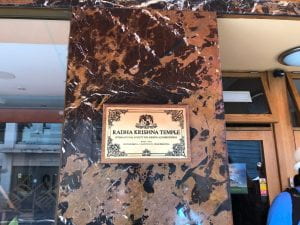ISKON, or the International Society for Krishna Consciousness, was founded by Bhaktivedanta Swami Prabhupad in the 1960s. Prabhupad is an important figure of the religious movement because his written scriptures defined the proper devotion of Krishna. On my visit to the temple, I noticed a statue of Prabhupad at the back of the room, which was constantly interacted with and given the same offerings as the rest of the devotees. According to ISKCON’s Search for Self-Identity Prabhupada was significant because “it was he who knew what Krishna Consciousness was and how to achieve it; and it was he who had the charismatic authority to draw others into what to all of them was a totally unfamiliar tradition” (Hopkins, 174).
From my short time at the ISKCON temple, I learned that the Hare Krishna movement is characterized by specific rituals and rules that stem from Hinduism. For instance, one of the first things I noticed was the simplicity of the Hare Krishna’s appearance. Some men shaved their heads and wore orange robes as a sign of renunciation, an important Hindu practice. Many of the other followers wore simple clothing to emphasize the importance of the soul, rather than bodies. In addition to a disciplined wardrobe, Hare Krishna’s followed a structured lifestyle devoid of meat, illicit sex, and materialism.
While the appearance of the Hare Krishna’s was untraditional, perhaps one of the most defining characteristics of the movement is the style of worship. Devotees gather to sing, dance, and chant “Hare Krishna” over and over again. They believe that the most powerful form of worship is to chant the names of God. In the temple, a curtain was pulled back to reveal the display of deities that would be worshiped during the service. Items were offered to the deities and in returned, members of the service were presented with fire, water, and flowers to help feel the bliss of Hare Krishna as well as provide purification.
At first, the movement was small, as it started with one temple in New York, but it quickly expanded across the world, especially in Europe and America. Now it was an international religious organization with nearly 100 centers. The movement was particularly popular in regions of high immigration rates, as “Indian immigrants were drawn to ISKCON’s temples and activities as a way to maintain their religious identity as they adjusted to a new culture” (181). Others joined the movement to advance their Hindu faith and strengthen the bonds to their gods.


